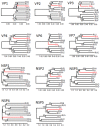Whole Genome Sequence Analysis of a Prototype Strain of the Novel Putative Rotavirus Species L
- PMID: 35336869
- PMCID: PMC8954357
- DOI: 10.3390/v14030462
Whole Genome Sequence Analysis of a Prototype Strain of the Novel Putative Rotavirus Species L
Abstract
Rotaviruses infect humans and animals and are a main cause of diarrhea. They are non-enveloped viruses with a genome of 11 double-stranded RNA segments. Based on genome analysis and amino acid sequence identities of the capsid protein VP6, the rotavirus species A to J (RVA-RVJ) have been defined so far. In addition, rotaviruses putatively assigned to the novel rotavirus species K (RVK) and L (RVL) have been recently identified in common shrews (Sorex araneus), based on partial genome sequences. Here, the complete genome sequence of strain KS14/0241, a prototype strain of RVL, is presented. The deduced amino acid sequence for VP6 of this strain shows only up to 47% identity to that of RVA to RVJ reference strains. Phylogenetic analyses indicate a clustering separated from the established rotavirus species for all 11 genome segments of RVL, with the closest relationship to RVH and RVJ within the phylogenetic RVB-like clade. The non-coding genome segment termini of RVL showed conserved sequences at the 5'-end (positive-sense RNA strand), which are common to all rotaviruses, and those conserved among the RVB-like clade at the 3'-end. The results are consistent with a classification of the virus into a novel rotavirus species L.
Keywords: genome sequence; phylogeny; rotavirus; taxonomy; virus species.
Conflict of interest statement
The authors declare no conflict of interest. The funders had no role in the design of the study; in the collection, analyses, or interpretation of data; in the writing of the manuscript, or in the decision to publish the results.
Figures

References
-
- Troeger C., Khalil I.A., Rao P.C., Cao S., Blacker B.F., Ahmed T., Armah G., Bines J.E., Brewer T.G., Colombara D.V., et al. Rotavirus Vaccination and the Global Burden of Rotavirus Diarrhea Among Children Younger Than 5 Years. JAMA Pediatr. 2018;172:958–965. doi: 10.1001/jamapediatrics.2018.1960. - DOI - PMC - PubMed
-
- Otto P.H., Rosenhain S., Elschner M.C., Hotzel H., Machnowska P., Trojnar E., Hoffmann K., Johne R. Detection of rotavirus species A, B and C in domestic mammalian animals with diarrhoea and genotyping of bovine species A rotavirus strains. Vet. Microbiol. 2015;179:168–176. doi: 10.1016/j.vetmic.2015.07.021. - DOI - PubMed
Publication types
MeSH terms
LinkOut - more resources
Full Text Sources
Medical

